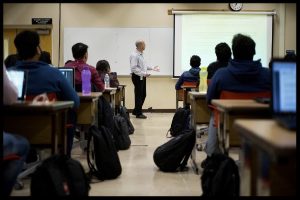
Photo: James Tensuan
Shai Silberman, center, a lecturer in the Charles W. Davidson College of Engineering and the director of Network Services for the university, uses Wi-Fi in his class while students follow a lecture on their laptops.
By David Goll
Expansion of access to wireless technology in all of the buildings and many outdoor spaces throughout the 154 acres of San Jose State University has been one of the most dramatic impacts of the Vision 2017 campus improvement program.
Started in 2012, the Agility Through Technology segment of Vision 2017 brought uniform Wi-Fi access to classrooms, offices, residence halls, the Dr. Martin Luther King Jr. Library and major campus gathering spots such as the Student Union. Work that led to the installation of hardware facilitating wireless access started during the 2013-14 academic year when wireless access points at the university grew from 500 to 1,600. The entire campus was surveyed in fall 2013 and three contracting firms were brought in to install cabling throughout much of the campus during the winter break in January 2014. According to Shai Silberman, a lecturer in the Charles W. Davidson College of Engineering and director of Network Services for the university, subsequent expansion work has increased that number to 2,500 wireless access points today.
“As a result, we have seen an exponential rise in the number of (wireless technology) users on campus,” Silberman said. “Today, there are more users than ever on the network. We have had up to 18,000 users at a single time.”
The campus has 50 major buildings, including 23 devoted to academics and seven student residence halls. Silberman said the Wi-Fi expansion has cost the university about $2 million to date.
In his computer engineering classes, Silberman said the expanded use of wireless technology has helped him achieve a paperless classroom.
“I have found it to be a real asset to teaching and it enhances the ability of my students to collaborate with one another,” he said. “Students who might have problems asking questions of a professor feel much more comfortable asking another student. I feel it has encouraged greater participation in my classes.”
Using the wireless network, students can access the university’s learning management system (LMS), Canvas. The LMS system is used by students like Helena Xin every day.
“Most of my professors use it, but not all,” said Xin, a junior majoring in health science. “I use it all the time. We take tests on it, do homework and research on it, and can see our grades. It’s really vital for students.”
Xin and her fellow students will use Wi-Fi access during class for both academic — and, at times — non-academic reasons.
“There are times people will use it for shopping and looking at puppies,” she said.
Kimberly Cheng, a junior majoring in computer engineering, said she can communicate more easily with fellow students and faculty. She also frequently uses it to gain access to social media.
“I find using it during class is not always a distraction,” Cheng said. “It can actually help you stay alert and more engaged during a lecture, for example.”
Karthick Sadanap, a graduate student in computer engineering who arrived at SJSU from his home in Bangalore, India in 2015, has found Wi-Fi useful when recruiting other students to his Spartan Toastmasters club, a university chapter of the international organization dedicated to improving public speaking skills.
“Most people on campus have never heard of Toastmasters,” Sadanap said. “When we have outdoor recruiting fairs, we have tables with computers access to the network, allowing us to share information with potential members.”
Silberman noted SJSU, a major generator of employees for Silicon Valley, is inthe forefront of universities providing universal access to wireless devices.
Since the network has been so successful, it is “taken for granted that it will work, be fast and not deny access no matter how many devices you have connected or people standing around you have connected,” said Mike Wardley, SJSU’s director of Project Management and User Experience.
“The network access at SJSU, particularly wireless access, was designed to be lightning fast and ubiquitous across the campus,” Wardley stated. “Having a wireless network that supports more than 18,000 concurrent devices on a daily basis means that students, staff and faculty can wander around campus, focusing on their particular task or objective without worrying whether they will lose their wireless connection or be hit by the infamous ‘can you connect now’ mantra.”